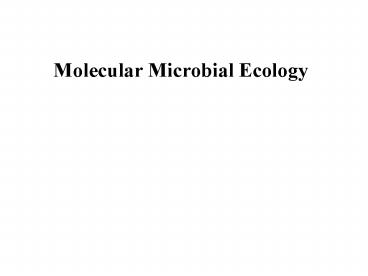Molecular Microbial Ecology - PowerPoint PPT Presentation
1 / 50
Title:
Molecular Microbial Ecology
Description:
Molecular Microbial Ecology – PowerPoint PPT presentation
Number of Views:191
Avg rating:3.0/5.0
Title: Molecular Microbial Ecology
1
Molecular Microbial Ecology
2
???
???
???
???
3
???
???
???
???
4
The Challenge for Microbial Ecology
Habitat Culturability ()
Seawater 0.001-0.1
Freshwater 0.25
Sediments 0.25
Soil 0.3
How do you study something you cant grow in the
lab?
From Amann et al. 1995 Microbiological Reviews
5
(No Transcript)
6
The grand picture, from environment to
identification
Head et al. 1998
7
A more classical approach
Head et al. 1998
8
- Ribosomal RNA (rRNA)
- Everybody has it
- Contains both highly conserved and variable
regions - -allows making comparisons between different
organisms - over long periods of time (evolutionary history)
- Not laterally transferred between organisms
- Huge and growing database
9
Universal Tree of Life
BACTERIA
BACTERIA
ARCHAEA
ARCHAEA
You Are Here
EUKARYA
EUKARYA
10
Primers can be designed to amplify hypervariable
regions, but are specific to Eubacteria vs. Archae
- 16S rRNA Bacteria primer pairs
- Several hypervariable regions
- 16S rRNA Archaea primer pairs
- Several hypervariable regions
- Usual procedure in molecular microbial ecology
- Obtain environmental sample (soil, seawater,
fresh water, organism such as human gut) - Extract total DNA
- PCR amplify and obtain amplicons
- Or clone DNA, and grow up clones
- Genotype/sequence DNA
- Characterize microbial diversity
11
Alternative routes for molecular ecological
studies in microbiology
- Get community fingerprint via T-RFLP
fingerprint profiles - Get community fingerprint via DGGE and sequence
bands - Get species identification by
- Clone and sequence clones
- Skip cloning, go straight into sequencing
(massively parallel sequencing, MPS)
12
(No Transcript)
13
(No Transcript)
14
(No Transcript)
15
(No Transcript)
16
(No Transcript)
17
Alternative routes for molecular ecological
studies in microbiology
- Get community fingerprint via T-RFLP
- Get community fingerprint via DGGE and sequence
bands - Get species identification by
- Clone and sequence clones
- Skip cloning, go straight into sequencing
(massively parallel sequencing, MPS)
18
(No Transcript)
19
(No Transcript)
20
Denaturing gradient gel electrophosis (DGGE) DNA
melts at a certain point
21
What do you do with the sequences?
- Perform a similarity search (database)
- Align the sequences (common ancestry)
- Build a tree (phylogeny and taxonomy)
22
BLASTBasic Local Alignment Search Tool
http//blast.ncbi.nlm.nih.gov/Blast.cgi
23
Alignments of sequences
24
(No Transcript)
25
(No Transcript)
26
Alternative routes for molecular ecological
studies in microbiology
- Get community fingerprint via T-RFLP
- Get community fingerprint via DGGE and sequence
bands - Get species identification by
- Clone and sequence clones
- Skip cloning, go straight into sequencing
(massively parallel sequencing, MPS)
27
(No Transcript)
28
- Built clone libraries from deep-sea rocks
- Compared them to one another and other habitats
29
16S RNA sequences
Santelli et al. 2008
30
Community Overlap
Santelli et al. 2008
31
Alternative routes for molecular ecological
studies in microbiology
- Get community fingerprint via T-RFLP
- Get community fingerprint via DGGE and sequence
bands - Get species identification by
- Clone and sequence clones
- Skip cloning, go straight into sequencing
(massively parallel sequencing, MPS)
32
MPS Approaches
Schematic courtesy of B. Crump
33
The next generation sequencing methods
Platform Million base pairs per run Cost per base (cents) Average read length (base pairs)
Dye-terminator (ABI 3730xl) (classic method) 0.07 0.1 700
454-Roche pyrosequencing (next gen.) 400 0.003 400
Illumina sequencing (next gen.) 2,000 0.0007 35
From Hugenholtz and Tyson 2008
34
(No Transcript)
35
V3, V6 and V6 hypervariable regions in 16S rRNA
genes, and taxon specific conserved primer sites
for PCR (coverage species amplified)
36
How many species in 1 L of vent fluid?
gt 36,000 eubacterial species!
3,000 archea species
37
Now we know who is thereWhat next?
- Quantify particular groups FISH or qPCR
38
Head et al. 1998
39
Fluorescent In-Situ Hybridization (FISH)
Schleper et al. 2005
40
Quantitative (Real Time) PCR
- Detection of amplification-associated
fluorescence at each cycle during PCR - No gel-based analysis
- Computer-based analysis
- Compare to internal standards
- Must insure specific binding of probes/dye
41
Quantitative PCR
42
(No Transcript)
43
Primers used to amplify mcrA, an important gene
for adaptation to anoxic sediments (note
different primers are used to detect different
groups)
44
(No Transcript)
45
(No Transcript)
46
Now we know who and how manyWhat next?
- Metagenomics
- RNA-based methods
- Many many more
47
Metagenomics a.k.a., Community Genomics,
Environmental GenomicsDoes not rely on Primers
or Probes (apriori knowledge)!
Image courtesy of John Heidelberg
48
Metagenomics
Access genomes of uncultured microbes Functional
Potential Metabolic Pathways Horizontal Gene
Transfer
49
From the Most Simple Microbial Communities
- Acid Mine Drainage (pH 0!)
- Jillian Banfield (UC Berkeley)
- Well-studied, defined environment with 4
dominant members - Were able to reconstruct almost entire community
metagenome - Tyson et al. 2004
50
to the potentially most diverse!
Venter et al. 2004
- The Sorcerer II Global Ocean Sampling Expedition
- J. Craig Venter Institute Sequence now, ask
questions later - Very few genomes reconstructed
- Sequenced 6.3 billion DNA base pairs (Human
genome is 3.2) from top 5 m of ocean - Discovered more than 6 million genes and they
are only halfway done!































